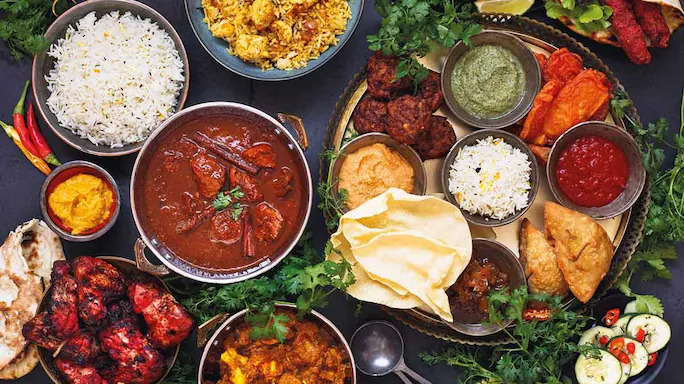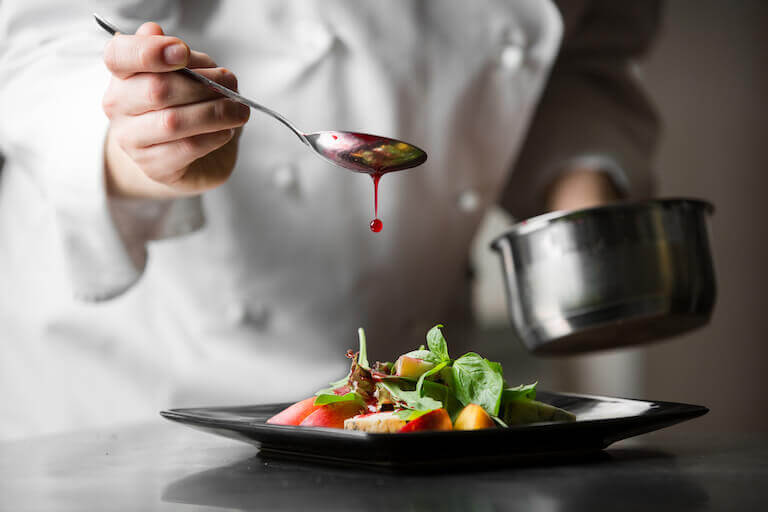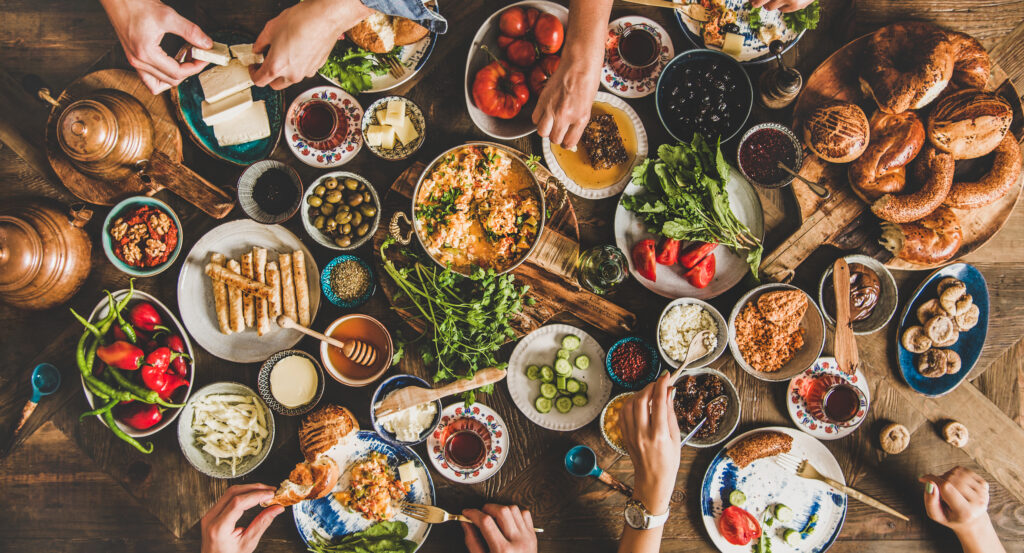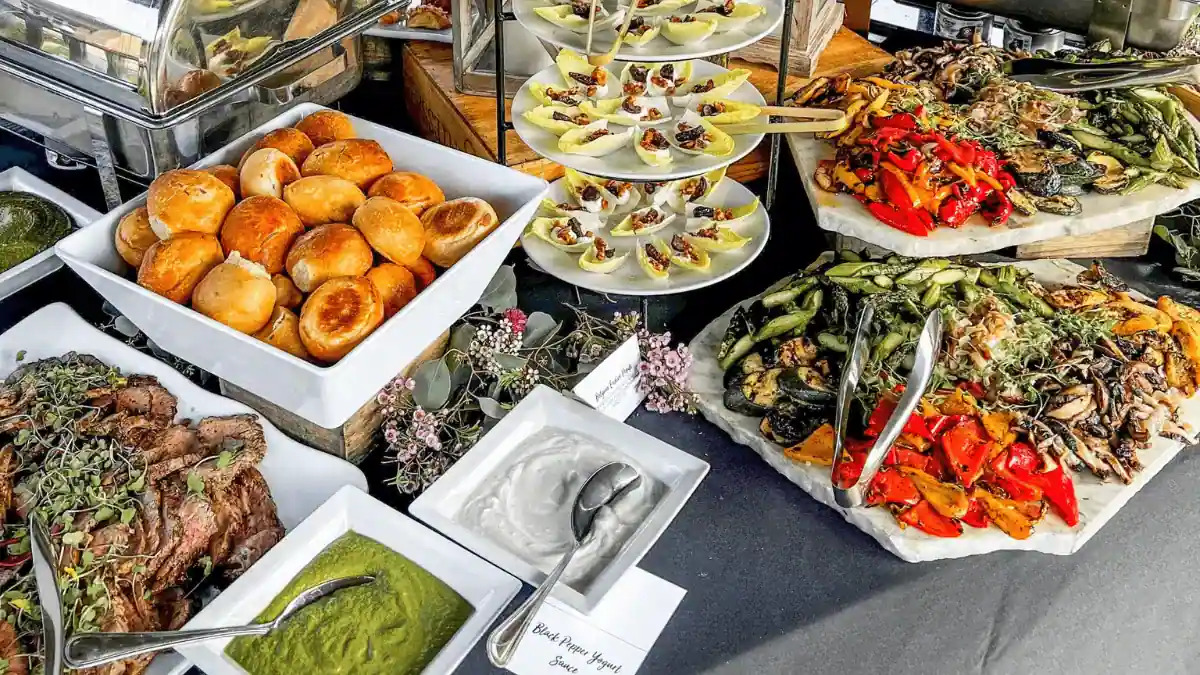Deciding what to serve at a wedding reception is a pivotal choice that significantly shapes the event’s atmosphere and leaves an indelible mark on the guests. This choice not only influences the overall experience but also expresses the couple’s personality, weaving their tastes, cultural backgrounds, and the essence of their love story into the fabric of the celebration. From the elegance of plated sit-down dinners to the warmth of family-style meals, and the variety offered by buffet-style dinners to the casual charm of self-serve stations and cocktail-style gatherings, the wedding menu beckons as a canvas awaiting the couple’s unique imprint.
As couples embark on the journey to tailor a wedding menu, they are met with an abundant palette of options ranging from comforting regional delicacies to the innovative blends of fusion cuisine. The process of selecting a caterer becomes a quest for harmony between authentic flavors, seasonal freshness, and personal touches like a signature cocktail or a cherished family recipe that resonates with joy. Furthermore, embracing diversity through wedding food, catering to various dietary needs, and aligning with wedding venues to create a seamless experience, transform the wedding reception into a memorable feast that celebrates love in the most delectable manner. Through this guide, readers will discover how to curate a wedding menu that harmonizes regional and fusion menus, ensuring that their wedding food ideas are as extraordinary as their love story.
The Art of Selecting Regional Delicacies

Embarking on the journey of selecting regional delicacies for a wedding reception is both an exciting and thoughtful process. It’s about creating a menu that not only tantalizes the taste buds but also pays homage to the cultural roots and personal stories of the couple. Here’s how to artfully navigate the vast culinary landscape:
1. Reflecting Personalities and Cultures:
- Feature Cultural Cuisine: Sushi rolls, tamales, or biryani are not just dishes; they are stories on a plate that connect hearts through taste. Incorporating such items can transform the wedding feast into a culinary exploration.
- Local and Seasonal Selections: Emphasize the importance of season and location by choosing locally sourced and in-season items, such as chicken and beer in Maine or a Mediterranean table and wine. This not only supports local producers but also ensures freshness and quality.
- Dietary Considerations: It’s crucial to accommodate dietary restrictions by providing a variety of options, including vegetarian and vegan choices, and using menu cards to inform guests.
2. Menu Format and Presentation:
- Station Style vs. Plated Meal: Decide between the variety offered by station-style menus and the formality of plated meals. This choice significantly impacts the dining experience and interaction among guests.
- Small Plates Trend: Embrace the trend of small plates for their unique flavors and cute presentation. It allows guests to sample a wide range of dishes without feeling overwhelmed.
- Tasting Sessions: Schedule tasting sessions with caterers to ensure the menu aligns with the couple’s tastes and expectations.
3. Traditional Wedding Menus by Location:
- Mexico: Tamales, pork carnitas, enchiladas mole, chiles rellenos, and fresh warm tortillas and rice.
- Jamaica and the Caribbean: Jerk chicken, curry chicken, cou-cou, rice dishes, curried goat, flying fish dishes, and fried plantain.
- Costa Rica: Casados, local and fresh seafood dishes, and beachside barbecue.
Incorporating local cuisine into various courses and events, such as the welcome dinner or breakfast the day after, adds a touch of authenticity and charm. Whether the venue is all-inclusive or not, trying and incorporating local dishes into the menu can make the wedding reception a memorable culinary journey for everyone involved.
Fusion Cuisine: Where Traditions Meet Innovation

Fusion Cuisine: Where Traditions Meet Innovation introduces a thrilling culinary adventure, seamlessly blending the essence of various cultures into a harmonious menu. This innovative approach to wedding food caters to the adventurous spirit, promising an unforgettable dining experience that celebrates diversity and creativity.
- Creating a Cohesive Menu:
- Collaborate with caterers specializing in distinct cultural cuisines to craft a unified buffet or plated menu.
- Discuss fusion menu ideas with wedding catering services, focusing on emphasizing the blend of traditions.
- Examples of innovative dishes include Chicken Tikka Pizza, Pasta with Paneer Makhani Sauce, and Naan Bruschetta, showcasing how traditional flavors can be presented in a modernized way.
- Respecting Cultural Sensitivities:
- When blending cuisines, it’s paramount to respect traditions and cultural beliefs to ensure inclusivity and avoid offending guests.
- Introduce guests to the fusion menu through the wedding program, providing insights into the traditions and customs celebrated.
- Fusion cuisine examples like Char Sui Pork Salad, XO Scallops, and Asian Wonton Soup illustrate the respectful and exciting integration of different culinary worlds.
- Fusion Desserts – A Sweet Finale:
- Fusion desserts like Black Sticky Rice, Green Tea Bao, and Black Sesame Ice Cream offer a unique ending to the wedding meal, blending different cultural elements and flavors.
- Innovative serving ideas, such as Mango Lassi Popsicles and Tacos as desserts, add a fun and modern touch to traditional dishes.
- Discussing dessert options with caterers ensures that the sweet course remains a memorable part of the fusion dining experience, leaving guests delighted and surprised.
This journey through Fusion Cuisine: Where Traditions Meet Innovation showcases the boundless possibilities when cultures converge on a plate. By thoughtfully combining different culinary traditions, couples can offer their guests a taste of their unique love story, crafted with respect, creativity, and a dash of innovation.
Celebrating Diversity with Authentic Flavors

Understanding the roots of each tradition is crucial when incorporating authentic cultural traditions into a multicultural wedding. By delving into the origins and meanings behind these traditions, couples can ensure their celebration is not just a visual feast but a deeply meaningful experience. Here are some ways to celebrate diversity with authentic flavors:
- Stationery That Tells a Story: Use wedding stationery to share the journey of your love and the fusion of cultures. Invitations, programs, and menu cards can feature designs inspired by both cultures, and include brief explanations of the significance behind each ceremonial element or dish served. This not only educates guests but also enhances their appreciation and engagement with the celebration.
- Ceremonial Rituals and Attire:
- Rituals: Incorporating ceremonial rituals like lighting unity candles or sharing traditional sweets can bridge generations and cultures, creating a poignant moment of unity and respect.
- Attire: Encourage the bridal party and guests to wear traditional garments, such as sarees, sherwanis, or kente cloth. This visual representation of diverse cultures adds depth and vibrancy to the celebration, telling stories of heritage and belonging.
- Interactive Cultural Elements:
- Music and Dance: Include cultural music and dances to invigorate the celebration, inviting guests to partake in a shared rhythmic experience that transcends cultural boundaries.
- Decor and Activities: Transform the venue with décor that reflects the rich tapestry of both cultures. Consider interactive stations like henna or traditional tea-serving areas, which not only serve as entertainment but also as educational experiences for guests.
By weaving these elements thoughtfully into the wedding, couples honor their roots while creating a space where diverse traditions and flavors meet. This approach not only pays homage to family legacies but also crafts a unique and unforgettable celebration that stands as a testament to the couple’s shared future and the blending of their worlds.
Curating Your Fusion Wedding Menu

Curating a fusion wedding menu that reflects both your personalities and those of your guests, while ensuring a memorable and engaging dining experience, involves a harmonious blend of creativity, tradition, and interactive elements. Here’s how to achieve that perfect balance:
- Personal Touches & Guest Considerations:
- Share Your Love Story: Incorporate dishes that have significance to your relationship or individual cultures, such as a dessert from the country where you got engaged or a family recipe passed down through generations.
- Cater to All: Ensure the menu has something for everyone by including a variety of appetizers like shrimp, crab cakes, and vegetarian options like eggplant sticks. Remember to accommodate dietary restrictions with gluten-free and vegan choices, making every guest feel valued.
- Interactive Elements: Engage your guests with interactive stations such as a sushi bar, a carving station featuring prime rib or turkey, or action stations where chefs prepare dishes live, sharing stories behind the food.
- Menu Design & Presentation:
- Start with an Amuse-Bouche: Begin the meal with a small, intriguing bite that sets the tone for the culinary journey ahead.
- Elegance in Service: Offer an elegant full course meal with tableside service or small plates passed around, allowing guests to try a variety of dishes without overwhelming them. Consider adding a special touch with punch bowl cocktail carts or tray-passed small plates for a unique experience.
- Visual Appeal: Ensure the food is not only delicious but also visually appealing. Use large format ice cubes in cocktails and beautifully presented dishes to create an Instagram-worthy experience.
- Creating Lasting Memories:
- Taste and Re-taste: Work closely with your caterer, tasting and refining dishes to ensure they perfectly capture the essence of your fusion menu. Trust their expertise but don’t be afraid to incorporate your personal favorites.
- Seasonal and Fresh: Incorporate seasonal ingredients and flavors, especially if your wedding has a specific theme like a beachside celebration, which calls for fresh seafood and tropical flavors.
- Signature Touches: Elevate the experience with signature cocktails or mocktails that reflect your personalities, adding an extra layer of sophistication and personalization to the celebration.
By thoughtfully curating your fusion wedding menu, you not only cater to the tastes of your guests but also share a piece of your love story, making the dining experience at your wedding truly unforgettable.
Embracing Sustainability in Your Wedding Menu Choices

Embracing sustainability in your wedding menu choices is not just a trend; it’s a commitment to the planet and future generations. Here’s how to make your wedding reception both delicious and environmentally friendly:
Sustainable Food Choices
- Locally Grown Food: Opting for locally sourced ingredients reduces transportation emissions and supports the local economy. Imagine the vibrant flavors of a salad made with heirloom tomatoes picked just miles away, or the rich taste of locally raised poultry. Local sourcing means your food travels fewer miles from farm to table, enhancing taste and reducing carbon footprints.
- Seasonal Selections: Aligning your menu with the seasons ensures that you’re getting the freshest, most flavorful produce while supporting local farming cycles. Picture a summer wedding with a menu that features a refreshing watermelon and feta salad or a cozy winter reception with a warm butternut squash soup.
- Vegetarian Options: With the environmental impact of meat production, offering plant-based meals is a powerful step toward sustainability. Dishes like grilled portobello mushrooms or a hearty lentil stew can be both satisfying and eco-friendly.
Waste Reduction Strategies
- Plated Dinners vs. Buffets: Plated meals can significantly reduce food waste by controlling portions. Unlike buffets, where guests might take more than they can eat, plated dinners offer a predetermined amount of food, minimizing leftovers and waste.
- Eco-friendly Dinnerware: For a less formal or outdoor reception, consider using biodegradable or compostable plates and utensils. These options reduce plastic waste and can be turned into compost, contributing to soil health rather than lingering in landfills.
- Composting: Plan for the composting of food scraps. This not only reduces the amount of waste going to landfills but also turns potential waste into a resource, creating nutrient-rich soil for future food production.
Supporting Sustainability Beyond the Menu
- Eco-friendly Drinks: Seek out wineries and breweries that prioritize sustainability, from using organic grapes to implementing water conservation practices. Serving beverages from such producers sends a strong message about your commitment to the environment.
- Catering Choices: Choose a caterer who shares your values of sustainability, whether through sourcing local ingredients, minimizing waste, or using eco-friendly packaging. Their expertise can guide you in making choices that align with your vision of a sustainable celebration.
- Inclusive Offerings: Ensure your menu is inclusive by providing options for guests with dietary restrictions. This not only makes everyone feel welcome but also aligns with sustainable practices by offering diverse food choices.
By integrating these sustainable practices into your wedding menu, you not only create a memorable culinary experience but also contribute positively to the environment and local community. Your wedding becomes a testament to your love not just for each other, but for the planet as well.
Conclusion
In crafting a wedding reception menu that reflects both personal and cultural narratives, couples can create an event that not only tantalizes taste buds but also resonates deeply with every guest, weaving the rich tapestry of their love story into the culinary experience. By artfully balancing traditional regional delicacies with innovative fusion cuisine, and placing a strong emphasis on sustainability and inclusivity, the path is laid for a celebration that is both unique and unforgettable. This approach not only honors the past and present but also sets a mindful precedent for the celebrations of future generations, encapsulating a love that is as expansive as it is intimate.
Finding the perfect balance between authenticity and innovation, personal touches and broad appeal, can be a complex yet rewarding journey. The key lies in collaborating with professionals who share your vision and values, ensuring every detail contributes to the grand tapestry of your special day. To find the right wedding vendors and caterers who can bring your dream menu to life, consider visiting venuelook.com. Through thoughtful planning, your wedding reception can become a cherished memory that stands as a testament to the unique blend of cultures, tastes, and hearts, forever reminding us of the power and beauty of love.
FAQs
Q: What are appropriate food options to offer at a wedding reception?
A: A typical wedding reception buffet might feature a selection of entrees such as chicken and beef, along with pasta, a variety of side dishes, salad, and dinner rolls. It’s important to cater to all guests by providing vegan choices and dishes that accommodate dietary restrictions. Personalizing the menu with a favorite dish, whether it be seafood, lamb, or another specialty, is also a thoughtful touch.
Q: Can you describe a traditional American wedding menu?
A: A traditional American wedding menu often includes appetizers like Classic Shrimp Cocktail with fresh lemon and cocktail sauce, a Hot Artichoke & Red Pepper Dip with a four-cheese blend served with bread, and seasoned Deviled Eggs. The main course may feature dishes such as Roasted Prime Rib or Grilled Chicken Americana, complemented by sides like Creamy Whipped Potatoes and a Sunburst Vegetable Medley. A fresh Green Garden Salad is commonly served as well.
Q: What is the most popular dish served at weddings?
A: The most popular dishes at weddings tend to be those that are considered fine dining and add to the grandeur of the event. Guests often enjoy indulgent and visually appealing options like filet mignon, lobster, or rack of lamb, which are commonly served at traditional wedding celebrations.
Q: What does “reception style serving” mean?
A: Reception style serving refers to the method of dinner service provided to guests at a wedding. Hosts typically have three main options to choose from: a Buffet, where guests serve themselves from a variety of dishes; a Sit Down meal, which is a formal dinner service with guests seated; and Stations, which are different areas offering specific types of food or cuisines. The choice of reception meal style is a significant consideration as it usually represents a major portion of the wedding budget.
To find the right wedding vendors and caterers, visit venuelook.com.
For A-Z of wedding planning and decorations, contact us at weddings.venuelook.com.
You May Also Like:
- Unique Wedding Cake Ideas for a Bride-to-be!
- Impress Your Guests with 10 Quick Desserts
- Unique & Fresh Wedding Cake Flavours That You Must Try Out In 2021!
- Wedding Cakes That Are Overflowing With Sweetness
- Fruit Desserts for Upcoming Parties!
- Wedding Cake Toppers Perfect for a Desi Wedding!
- Top 11 Trending Wedding Themes 2020
Have you sent out invitations for your upcoming event? If not, save paper and send free online invitations now.
Looking for a party venue? Browse and book best-suited party venues from VenueLook.com
 Event, Party & Wedding Planning Tips & Ideas for Celebrations Party and Event Planning Tips, Resources and Venues
Event, Party & Wedding Planning Tips & Ideas for Celebrations Party and Event Planning Tips, Resources and Venues










